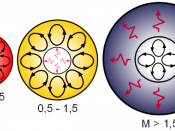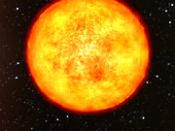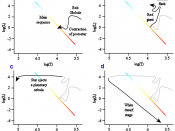Stars are born in high density areas of space called nebulas. A nebula (as defined by Dictionary.com) is: A diffuse mass of interstellar dust or gas or both, visible as luminous patches or areas of darkness depending on the way the mass absorbs or reflects incident radiation. The stars are born because of the gravity of the nebula acts on itself, condensing the gas and dust into a protostar.
A protostar is a very small star. The protostar begins to heat up, and if it has enough matter the core temperature reaches 15 million degrees Fahrenheit. At 15 million degrees Fahrenheit nuclear reactions occur in which hydrogen fuses to form helium. The star then begins to release energy which stops it from contracting, and it causes the star to shine. When a star starts to shine it is called a "main sequence star". A star remains in main sequence depending on its solar mass.
A star of about 1 solar mass will remain in main sequence for about 10 billion years. After all of the star's hydrogen has been used to form helium, it begins to cool down and the helium fuses to carbon and the star expands, becoming a red giant (when a star becomes a red giant with no more hydrogen left to burn it is out of the main sequence.)
The red giant keeps expanding until all of its helium runs out and then all of the outer layers drift away from the core as a gaseous shell. The gas that surrounds the core is called a "Planetary Nebula". The core that is left then becomes a "white dwarf". After the white dwarf cools down enough it stops shining and dies, forming a "black dwarf".
Another life cycle of a star involves a star with...


